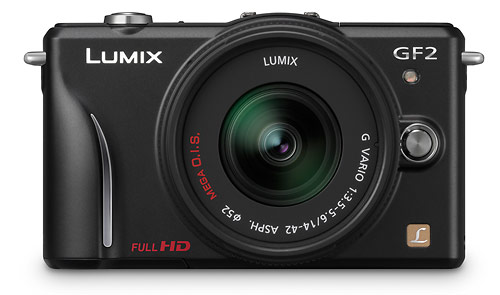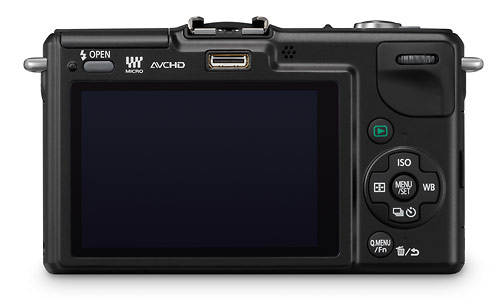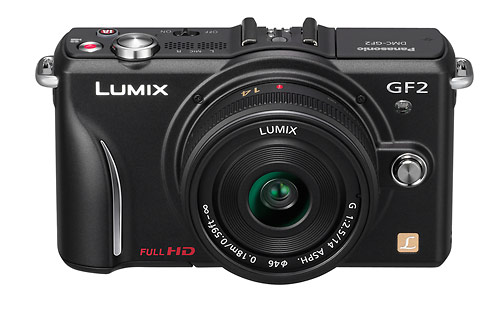 Panasonic has announced the follow-up to their popular Lumix GF1 Micro Four Thirds camera. The new Panasonic Lumix GF2 is smaller and lighter and trades the traditional camera controls found on the GF1 for a more consumer-friendly touchscreen control interface. It appears to use the same 12-megapixel Live MOS sensor as the GF1 but has improved image processing and video resolution has been increased to 1920 x 1080 at 60i. The new GF2 is compatible with Panasonic’s new 3D lens so it can be used for 3D photography and video.
Panasonic has announced the follow-up to their popular Lumix GF1 Micro Four Thirds camera. The new Panasonic Lumix GF2 is smaller and lighter and trades the traditional camera controls found on the GF1 for a more consumer-friendly touchscreen control interface. It appears to use the same 12-megapixel Live MOS sensor as the GF1 but has improved image processing and video resolution has been increased to 1920 x 1080 at 60i. The new GF2 is compatible with Panasonic’s new 3D lens so it can be used for 3D photography and video.
The main differences between the GF1 and the GF2 are the smaller, touchscreen-based design, the improved video specs, and the new Venus Engine FHD image processing. The GF2 will likely lose some GF1 fans because of its less retro, rangefinder-esque design. Panasonic is probably betting that the GF2 will appeal to amateurs and younger photographers who are used to the touchscreen controls on their smartphones and don’t really care how much their camera resembles a 40 year-old rangefinder. Overall, the GF2 is designed more for point-and-shoot consumers than traditional button and dial photographers. It’s also an answer to the success of Sony’s NEX mirrorless cameras and the consumer-friendly Olympus E-PL1 Micro Four Thirds camera (read our hands-on Olympus E-PL1 Pro Review). And you have to admit it’s pretty cool to focus by touching your subject on the LCD screen and then adjusting your depth-of-field with an on-screen slider (Peripheral Defocus mode).

The GF2 isn’t all about design, though. Although the sensor seems to be the same 12-megapixel Live MOS used in the GF1, the new Venus Engine FHD image processing (introduced in September with the Lumix GH2) is supposed to improve image quality. In the GF2 press release, Panasonic says,
| “Venus Engine FHD enables Intelligent Resolution technology, which means that three areas – outlines, detailed texture areas and soft gradation – are automatically detected. Then, the outline parts are enhanced effectively to give edges more clearness while giving a moderate accentuation to the texture areas to look more finely detailed. To the soft gradation part, noise reduction system is applied to make it smoother. Apart from the uniform enhancement of sharpness, the innovative technology Intelligent Resolution precisely performs signal processing pixel by pixel, resulting in images that are naturally clear and crisp in both video and photos.” |
I haven’t used the GF2 so I can’t personally judge the image quality. However, the new Olympus E-5 digital SLR, which I believe uses the same sensor, is at least a stop better in terms of noise than previous cameras that use the same sensor (Panasonic and Olympus Micro Four Thirds cameras and the Olympus E-30 and E-620 DSLRs). So I have no doubt that Panasonic has been able to squeeze more out of that 12-megapixel sensor. The question is, how much better? And how does it compare to the GF1, the Olympus E-5 (because that gives us an idea of what Olympus might have up their sleeve for their next Micro Four Thirds camera), and the Sony NEX cameras?
Besides improved image quality, the new Venus Engine FHD processing also allowed Panasonic to upgrade video resolution to 1920 x 1080 “full HD” at 60i as well as 1280 x 720 at 60p in the AVCHD format. The GH2 adds a built-in stereo microphone and a dedicated video button on the top of the camera, as well.
Key Panasonic Lumix GF2 Features and Specs:
- 12-megapixel Live MOS sensor
- 19% smaller and 7% lighter
- Video: 1920 x 1080 at 60i or 1280 x 720 at 60p in AVCHD w stereo sound
- New Venus Engine FHD image processing
- Dedicated video button
- 3-inch 460k-dot touchscreen LCD display
- Touchscreen focus selection and shutter release
- Touch Q-menu allows control customization
- Contrast detect auto focus with multiple-area AF, user-selectable 1-area AF, Face Detection, and AF Tracking
- iA Intelligent Auto mode for stills and video
- Full manual exposure control as well as program, aperture priority, shutter priority and 17 scene modes
- My Color mode – eight preset effects including Retro, Cinema, Monochrome, Silhouette, and user-defined Custom mode
- Peripheral Defocus mode allows blur (depth-of-field) control with touchscreen slider
- Micro Four Thirds lens mount
- Built-in pop-up flash
- Accessory port
- Optional Live View Finder (DMW-LVF1)
- Solid aluminum body
- Weight: 9.4 oz (265g)
- Dimensions: 4.4 x 2.7 x 1.3 inches (113 x 68 x 33mm)
Anyone who’s looking at high-end compact cameras like the Nikon Coolpix P7000, Canon PowerShot G12 or even Panasonic’s own LX5 should also take a hard look at the GF2 and other Micro Four Thirds / EVIL cameras. The GF2 is only a little bit bigger than a Canon G12 and it offers better performance, interchangeable lenses and DSLR image quality. Personally, if a camera doesn’t fit in my pants pocket, it needs to deliver more than any high-end compact. And that’s where cameras like the GF2 fit in – they’re significantly smaller and lighter than a digital SLR with very little compromise in terms of image quality or performance.
The original Panasonic GF1 was popular, in part, because of its traditional rangefinder styling. The GF2′s sleeker, touchscreen-based design is more 21st century. That will be a good thing for some and not so great for others. For me, styling is a non-issue as long as the controls are intuitive and easily accessible. The final equation is based on size, price and performance. The price is yet to be announced so that’s the X-factor for the GF2. But if it comes in around $600 it’s a sure winner. The one downside to choosing a Panasonic Micro Four Thirds camera is they don’t have built-in image stabilization like the Olympus Pen cameras. That limits your lens choices if you want image stabilization. On the other hand, the general consensus is the Panasonic Micro Four Thirds cameras have better image quality than their Olympus counterparts. Not that the Olympus Pen cameras are bad – to some extent we’re splitting hairs here. And then there’s the Sony NEX EVIL platform. The Sony NEX is even smaller than the GF2 and their larger sensor should have even better image quality. Choices – they’re a pain in the ass but it’s nice to have options, huh?
The Panasonic Lumix GF2 Micro Four Thirds camera should be in stores in January of 2011. It will be available in two kits with either the Panasonic 14mm f/2.5 lens or the Panasonic 14-42mm zoom. As I said, there’s no price yet but it should be announced 30 days before the camera is actually shipped. I’m predicting (fingers crossed) it’s around $600 because that makes it competitive with the Olympus E-PL1 and Sony NEX cameras as well as making it a reasonable step-up alternative to high-end compacts.
Panasonic Lumix GH2 Press Release >>
Compare to:
Panasonic Lumix GF1
Olympus E-PL1
Sony NEX-5
Related Content:
All Panasonic Digital Camera User Reviews
All Digital Camera User Reviews
EVIL & Micro Four Thirds Cameras Forum
More Panasonic Camera News
Panasonic Digital Cameras Web Site





I own a gf1. after reading what`s really new on this model I can`t imagine there`s a huge update. Kinda disapointed.
But nice post!
Thanks for a great review. I’ve been struggling between the Canon G12 , Lumix GF2 and the Sony NEX 5.
You’re review helped so much. The pricing is out of the Lumix GF2 and you got the pricing spot right at 600.
Thanks
The Canon G12 really doesn’t compare to the Panasonic GF2 and the Sony NEX cameras. That’s a no-brainer in my opinion. If you’re still considering the G12 because of size or price – don’t. Look at the S95 instead. It’s smaller, has the same sensor and will do most of what the G12 does. I really don’t see the point of the G-Series anymore.